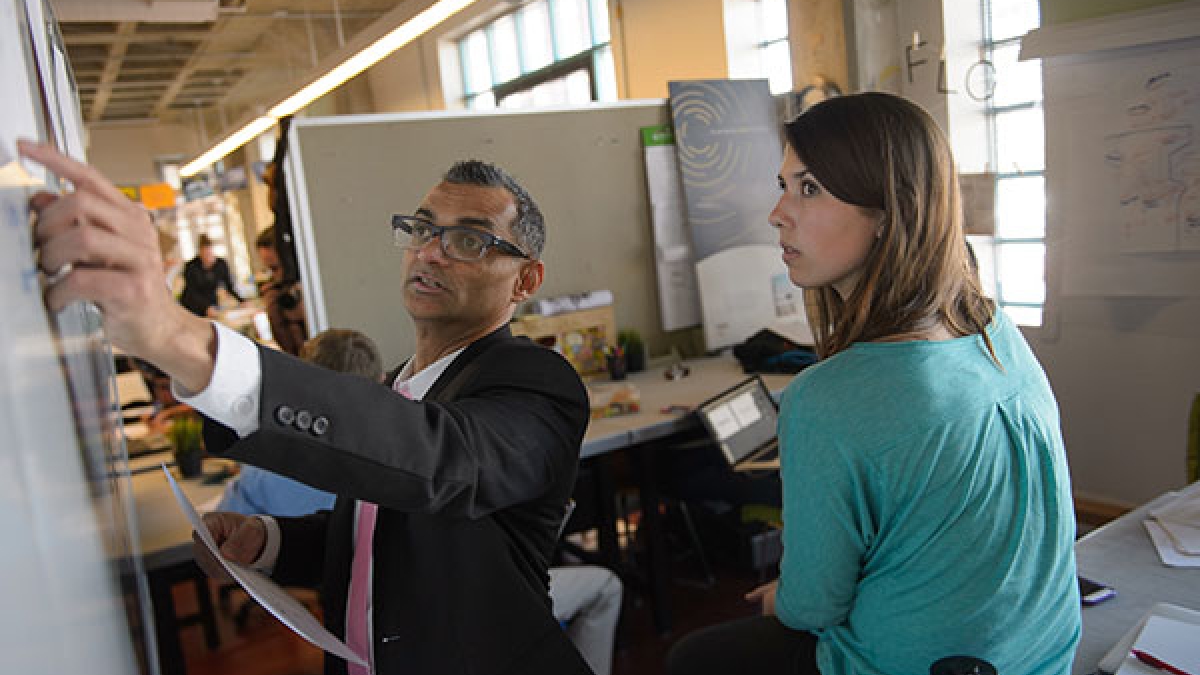New ASU center mimics nature to create cutting-edge technology

Launch symposium March 3 to feature Janine Benyus, ASU President Michael Crow
Arizona State University students Michelle Jack, Edmund Jolley, Jenna Stevens, Mark Small and Rubing Qiang are designing a smarter wheelchair cushion that gauges a user’s pressure points to increase comfort and prevent pressure sores.
As part of the InnovationSpace education and research space, they came up with several ideas for products that incorporate principles of nature into their design, including recycling and selling old cushions at affordable prices, reusing waste as raw material; and building a better wheel for a wheelchair using a honeycomb structure to reduce materials, and consequently cost, while still maintaining strength.
Their mentor and adviser Prasad Boradkar is a professor of industrial design in The Design School in ASU’s Herberger Institute for Design and the Arts. Every year, Boradkar and his colleague Adelheid Fischer work with a new batch of students who develop innovative, sustainable products with positive social impact using principles of biomimicry – a field that explores materials, processes and functions of nature to solve design and engineering problems.
InnovationSpace, co-directed by Boradkar and Fischer, is a joint venture among the Herberger Institute for Design and the Arts, Ira A. Fulton Schools of Engineering, W. P. Carey School of Business and School of Sustainability.
Exploring a new way of doing things
To ensure students are at the cutting-edge of education, sustainability and innovation, Fischer, Boradkar and an interdisciplinary team of ASU engineering, design, sustainability and business researchers first incorporated biomimicry into InnovationSpace projects in 2008.
Through Fischer and the group's efforts, ASU became a Biomimicry Affiliate University through The Biomimicry Institute, a nonprofit founded by Janine Benyus along with Bryony Schwan and Dayna Baumeister, a biomimicry pioneer, conservationist and professor of practice in the School of Life Sciences, within ASU's College of Liberal Arts and Sciences. Benyus explored the subject in depth and popularized it in her 1997 book, "Biomimicry: Innovation Inspired by Nature."
“Biomimicry thinking is a skill set for 21st century careers,” said Boradkar, who is also a senior sustainability scholar at ASU's Julie Ann Wrigley Global Institute of Sustainability. “We want our students to develop socially conscious products and think about how these products interact with their environment. From human-centered design, which has been a focus area longer than it should have, we should be thinking about life-centered design that incorporates our interaction with all organisms.”
Benyus’ first visit to ASU in 2008, as part of the Biomimicry Institute-ASU partnership led by Fischer, included a talk at the Memorial Union on the Tempe campus and furthered the relationship between The Biomimicry Institute and ASU.
Leveling up
Biomimicry studies have been a part of ASU’s research portfolio for years. Whether it is developing bio-inspired materials for modern use or finding ways to convert sunlight into energy by replicating photosynthesis in the lab, ASU researchers have been at the leading edge of the field.
During the spring commencement ceremony in 2013, ASU presented Benyus with an honorary doctorate for her groundbreaking work in the field of biomimicry. In a conversation prior to the ceremony, ASU President Michael M. Crow and Benyus discussed scaling up related initiatives at the university.
The result of that discussion, the Biomimicry Center at ASU, is set to launch on March 3. It is a joint collaboration between ASU and Biomimicry 3.8, the consulting and training firm co-founded by Benyus and Baumeister. The center will coordinate research and curriculum initiatives amongst campus institutions and the fast-growing global network of companies and consultants practicing biomimicry.
In addition to coordinating broad sustainability initiatives, the Biomimicry Center also will offer the first-ever Master of Science in Biomimicry and the first-ever Graduate Certificate in Biomimicry. These online programs are accredited versions of professional training programs developed by Biomimicry 3.8 since 2008.
Both the master’s degree and certificate programs have begun accepting applicants through ASU Online, and development of an on-campus master’s program is planned.
“The primary mission of the Biomimicry Center is to enhance academia’s ability to address a variety of sustainability challenges using strategies inspired by nature,” said Baumeister, co-director of the center and a professor of practice in the School of Life Sciences.
“We would like every ASU student to experience biomimicry principles as part of their education with the help of the center,” added Boradkar, who will co-direct the center with Baumeister. “We would also like to develop a mechanism through which our biomimicry research can come to life in the form of products and services.”
“Biomimicry allows us to put a face on sustainability and fall in love with it” said Fischer, who will serve as assistant director of the center. Boradkar said the study of biomimicry is exactly the kind of field that can thrive at a place like ASU.
“Innovative ideas take root and prosper at ASU. Biomimicry is a philosophy as well as methodology, and the Biomimicry Center will advance ASU’s mission to improve quality of life, sustainable development and economic competitiveness of our communities.”
The Biomimicry Center at ASU is supported by the Herberger Institute for Design and the Arts, College of Liberal Arts and Sciences, School of Sustainability, W. P. Carey School of Business, School of Life Sciences and Ira A. Fulton Schools of Engineering, as well as the Office of Knowledge and Enterprise Development and the Provost’s Office.
The center is scheduled to officially launch March 3 with an interactive symposium on ASU’s Tempe campus. The event will feature TED-style talks, hands-on activities, artistic performances and a discussion between Janine Benyus and ASU President Michael Crow about the role biomimicry can play in generating innovative solutions to sustainability challenges.